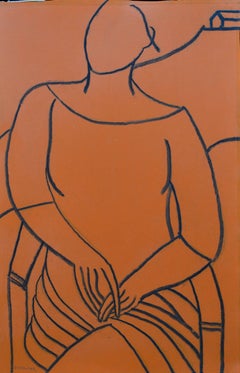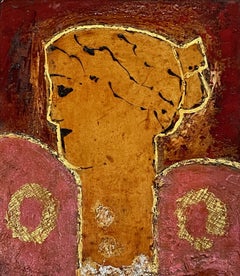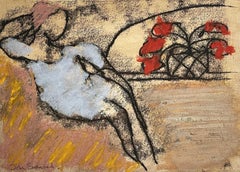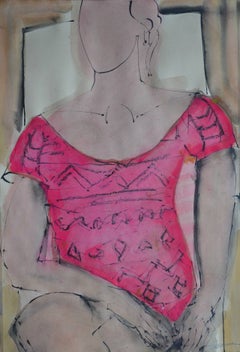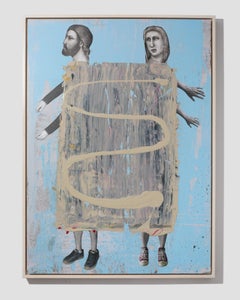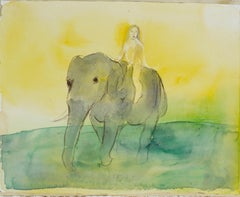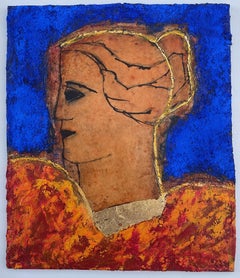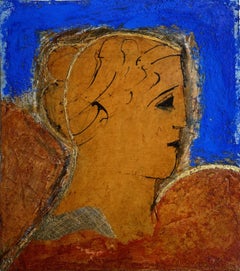John Emanuel Figurative Paintings
British, b. 1930
We are pleased to sell works on behalf of John Emanuel. John works in Porthmeor, Cornwall. He has received no formal art training. His natural creativity is inspired by a love of his subject – the figure and the figure embraced by the landscape, has developed into a consistent theme. His drawings exhibit a clear, classical form and a simplicity of line which strengthens the relationship between the contours of the figure and the contours of the land. He loves the singular beauty of the Cornish coastline and the extraordinary light. The notion of forms sleeping beneath the earth are a recurring theme. John works in a variety of media: charcoal, gouache, oils and, more recently mixed media and lino-types, a method he learned from John Wells. His preferred medium is oil paint using hand and mould made papers laid down on archive quality board.
John Emanuel “it is the figure , not the nude I am interested in…”
The art critic, Frank Ruhrmund has observed that…
“his works go beyond the nude. He has always striven to transcend the obvious and succeeded, and they have as much to do with the local landscape as they do with the human figure.”(Biography provided by White Court Art)
to
7
5
5
2
2
5
Overall Height
to
Overall Width
to
6
1
1
1
1
1
7
14
398
222
205
102
4
3
3
2
2
Artist: John Emanuel
Orange Mono Figure: Contemporary Mixed Media Figurative Painting by John Emanuel
By John Emanuel
Located in Brecon, Powys
Orange mono color from the studio of this very well collected British artist.
Image 21" x 15"
Originally from Bury, in the North of England, John Emanuel works in Porthmeor, Cornwa...
Category
21st Century and Contemporary Contemporary John Emanuel Figurative Paintings
Materials
Mixed Media
Classical Head: Contemporary Figurative Oil Painting by John Emanuel
By John Emanuel
Located in Brecon, Powys
Latest opulent work from the artist's Classical Head series.
Oil and gold leaf on board in white wood frame
Signed verso
Image 8.75" x 7". Framed 13" x 11.75"
Category
2010s Contemporary John Emanuel Figurative Paintings
Materials
Gold Leaf
Horizontal and Vertical Figures, Contemporary Figurative Oil Painting
By John Emanuel
Located in Brecon, Powys
Warm sepia tones in this classic Emanuel painting.
John Emanuel "it is the figure , not the nude I am interested in..."
Oil on board. Signed. Black wood frame
Category
21st Century and Contemporary Abstract John Emanuel Figurative Paintings
Materials
Oil
Orange Mono Figure: Contemporary Mixed Media Figurative Painting by John Emanuel
By John Emanuel
Located in Brecon, Powys
Orange mono color from the studio of this very well collected British artist.
Image 21" x 15"
Originally from Bury, in the North of England, John Emanuel works in Porthmeor, Cornwa...
Category
21st Century and Contemporary Contemporary John Emanuel Figurative Paintings
Materials
Mixed Media
Reclining With Tulips: Contemporary Figurative Mixed Media Painting
By John Emanuel
Located in Brecon, Powys
Classic John Emanuel figurative painting.
Mixed media on paper, signed and well framed. Excellent condition
Framed 13" x 16". Image 7.5" x 10.25"
21st Century
Category
Early 2000s Contemporary John Emanuel Figurative Paintings
Materials
Charcoal, Oil, Gouache
Sarah-Jane, Pink: Contemporary Mixed Media Figurative Painting by John Emanuel
By John Emanuel
Located in Brecon, Powys
John Emanuel embarking on a series of works using new life models. Unusual for a artist who has over the last 40 years only had 3 previous sitters. Now working with Sarah Jane...
Category
21st Century and Contemporary Contemporary John Emanuel Figurative Paintings
Materials
Gouache
Red Mono Figure: Contemporary Mixed Media Figurative painting by John Emanuel
By John Emanuel
Located in Brecon, Powys
Very pretty Emanuel pose.
"it is the figure , not the nude I am interested in..." J Emanuel
Image 20.5" x 14" Matted 25.5" x 19"
Signed
Originally from Bury, in the North of Engl...
Category
21st Century and Contemporary Contemporary John Emanuel Figurative Paintings
Materials
Mixed Media
Related Items
Sad Woman/Distant Man
By Holly Roberts
Located in Santa Fe, NM
"Sad Woman/Distant Man" illustrates Holly Roberts' shift from over-painting photographs to constructing photo-based images on top of abstract paintings. By combining the precision of photography with the expression of painting, Roberts marries objectivity with subjectivity, thus paralleling the dichotomy of human experience.
Like much of Roberts' contemporary work, "Sad Woman/Distant Man" is a psychoanalytic interpretation of human experience, particularly unrequited love—A woman stares longingly at a disinterested man. The couple is composed of photographs of appendages both modern and medieval in execution, alluding to the immutability of unrequited love as a motif in art and literature. The work's underlying abstract painting figuratively functions as the uninterpretable gulf between the two lovers...
Category
21st Century and Contemporary Contemporary John Emanuel Figurative Paintings
Materials
Mixed Media
Expressionist Figurative water color painting- Luckiness
Located in Beijing, CN
Expressionist Figurative water color painting by Zhang Chunyang
Title: Luckiness
Dimension: 29 x 36 cm
Material: Gouache, Watercolor on Paper
D...
Category
2010s Expressionist John Emanuel Figurative Paintings
Materials
Watercolor, Gouache, Handmade Paper
Free Shipping
H 11.42 in W 14.18 in
Expressionist Figurative water color painting- Series The Horse Whisper No.2-25
Located in Beijing, CN
Expressionist Figurative water color painting by Zhang Chunyang
Series The Horse Whisper No.2-25
Dimension: 29 x 36 cm
Material: Gouache, Watercolor on Paper
Date: 2013
Artist B...
Category
2010s Expressionist John Emanuel Figurative Paintings
Materials
Watercolor, Gouache, Handmade Paper
Zhang ChunyangExpressionist Figurative water color painting- Series The Horse Whisper No.2-25 , 2013
Free Shipping
H 11.42 in W 14.18 in
Untitled _ ''White Inferno'' series.
Located in T'bilisi, GE
The "White Inferno" series features crafted mixed media artworks, blending diverse mediums to create intense visual compositions. Incorporating collage p...
Category
21st Century and Contemporary Contemporary John Emanuel Figurative Paintings
Materials
Paint, Charcoal, Ink, Mixed Media, Oil, Spray Paint, Acrylic, Archival P...
The Abduction of the Sabine Women , a Renaissance drawing by Biagio Pupini
Located in PARIS, FR
This vigorous drawing has long been attributed to Polidoro da Caravaggio: The Abduction of the Sabine Women is one of the scenes that Polidoro depicted between 1525 and 1527 on the façade of the Milesi Palazzo in Rome. However, the proximity to another drawing inspired by this same façade, kept at the Ecole des Beaux-Arts, and to other drawings inspired by Polidoro kept at the Musée du Louvre, leads us to propose an attribution to Biagio Pupini, a Bolognese artist whose life remains barely known, despite the abundant number of drawings attributed to him.
1. Biagio Pupini, a Bolognese artist in the light of the Roman Renaissance
The early life of Biagio Pupini, an important figure of the first half of the Cinquecento in Bologna - Vasari mentions him several times - is still poorly known. Neither his date of birth (probably around 1490-1495) nor his training are known. He is said to have been a pupil of Francesco Francia (1450 - 1517) and his name appears for the first time in 1511 in a contract with the painter Bagnacavallo (c. 1484 - 1542) for the frescoes of a church in Faenza. He then collaborated with Girolamo da Carpi, at San Michele in Bosco and at the villa of Belriguardo.
He must have gone to Rome for the first time with Bagnacavallo between 1511 and 1519. There he discovered the art of Raphael, with whom he might have worked, and that of Polidoro da Caravaggio. This first visit, and those that followed, were the occasion for an intense study of ancient and modern art, as illustrated by his abundant graphic production.
Polidoro da Caravaggio had a particular influence on the technique adopted by Pupini. Executed on coloured paper, his drawings generally combine pen, brown ink and wash with abundant highlights of white gouache, as in the drawing presented here.
2. The Abduction of the Sabine Women
Our drawing is an adaptation of a fresco painted between 1525 and 1527 by Polidoro da Caravaggio on the façade of the Milesi Palace in Rome. These painted façades were very famous from the moment they were painted and inspired many artists during their stay in Rome. These frescoes are now very deteriorated and difficult to see, as the palace is in a rather narrow street.
The episode of the abduction of the Sabine women (which appears in the centre of the photo above) is a historical theme that goes back to the origins of Rome and is recounted both by Titus Livius (Ab Urbe condita I,13), by Ovid (Fasti III, 199-228) and by Plutarch (II, Romulus 14-19). After killing his twin brother Romus, Romulus populates the city of Rome by opening it up to refugees and brigands and finds himself with an excess of men. Because of their reputation, none of the inhabitants of the neighbouring cities want to give them their daughters in marriage. The Romans then decide to invite their Sabine neighbours to a great feast during which they slaughter the Sabines and kidnap their daughters.
The engraving made by Giovanni Battista Gallestruzzi (1618 - 1677) around 1656-1658 gives us a good understanding of the Polidoro fresco, allowing us to see how Biagio Pupini reworked the scene to extract this dynamic group.
With a remarkable economy of means, Biagio Pupini takes over the left-hand side of the fresco and depicts in a very dense space two main groups, each consisting of a Roman and a Sabine, completed by a group of three soldiers in the background (which seems to differ quite significantly from Polidoro's composition).
The balance of the drawing is based on a very strongly structured composition. The drawing is organised around a median vertical axis, which runs along both the elbow of the kidnapped Sabine on the left and the foot of her captor, and the two main diagonals, reinforced by four secondary diagonals. This diamond-shaped structure creates an extremely dynamic space, in which centripetal movements (the legs of the Sabine on the right, the arm of the soldier on the back at the top right) and centrifugal movements (the arm of the kidnapper on the left and the legs of the Sabine he is carrying away, the arm of the Sabine on the right) oppose each other, giving the drawing the appearance of a whirlpool around a central point of support situated slightly to the left of the navel of the kidnapper on the right.
3. Polidoro da Caravaggio, and the decorations of Roman palaces
Polidoro da Caravaggio was a paradoxical artist who entered Raphael's (1483 - 1520) workshop at a very young age, when he oversaw the Lodges in the Vatican. Most of his Roman work, which was the peak of his career, has disappeared, as he specialised in facade painting, and yet these paintings, which are eminently visible in urban spaces, have influenced generations of artists who copied them abundantly during their visits to Rome.
Polidoro Caldara was born in Caravaggio around 1495-1500 (the birthplace of Michelangelo Merisi, known as Caravaggio, who was born there in 1571), some forty kilometres east of Milan. According to Vasari, he arrived as a mason on the Vatican's construction site and joined Raphael's workshop around 1517 (at the age of eighteen according to Vasari). This integration would have allowed Polidoro to work not only on the frescoes of the Lodges, but also on some of the frescoes of the Chambers, as well as on the flat of Cardinal Bibiena in the Vatican.
After Raphael's death in 1520, Polidoro worked first with Perin del Vaga before joining forces with Maturino of Florence (1490 - 1528), whom he had also known in Raphael's workshop. Together they specialised in the painting of palace façades. They were to produce some forty façades decorated with grisaille paintings imitating antique bas-reliefs.
The Sack of Rome in 1527, during which his friend Maturino was killed, led Polidoro to flee first to Naples (where he had already stayed in 1523), then to Messina. It was while he was preparing his return to the peninsula that he was murdered by one of his assistants, Tonno Calabrese, in 1543.
In his Vite, Vasari celebrated Polidoro as the greatest façade decorator of his time, noting that "there is no flat, palace, garden or villa in Rome that does not contain a work by Polidoro". Polidoro's facade decorations, most of which have disappeared as they were displayed in the open air, constitute the most important lost chapter of Roman art of the Cinquecento. The few surviving drawings of the painter can, however, give an idea of the original appearance of his murals and show that he was an artist of remarkable and highly original genius.
4. The façade of the Milesi Palace
Giovanni Antonio Milesi, who commissioned this palace, located not far from the Tiber, north of Piazza Navona, was a native of the Bergamo area, like Polidoro, with whom he maintained close friendly ties. Executed in the last years before the Sack of Rome, around 1526-1527, the decoration of Palazzo Milesi is considered Polidoro's greatest decorative success.
An engraving by Ernesto Maccari made at the end of the nineteenth century allows us to understand the general balance of this façade, which was still well preserved at the time. The frescoes were not entirely monochrome, but alternated elements in chiaroscuro simulating marble bas-reliefs and those in ochre simulating bronze and gold vases...
Category
16th Century Old Masters John Emanuel Figurative Paintings
Materials
Ink, Gouache, Pen
Glassblowers WPA American Scene Mid- 20th Century Modern Figurative Workers 1932
By Harry Gottlieb
Located in New York, NY
Glassblowers WPA American Scene Mid- 20th Century Modern Figurative Workers. Dated and signed "32 Harry Gottlieb" lower right. Sight: 13 1/8" H x 18 1/4" W.
Harry Gottlieb, painter, screenprinter, educator, and lithographer, was born in Bucharest, Rumania. He emigrated to America in 1907, and his family settled in Minneapolis. From 1915 to 1917, Gottlieb attended the Minneapolis Institute of Arts. After a short stint as an illustrator for the U.S. Navy, Gottlieb moved to New York City; he became a scenic and costume designer for Eugene O"Neill's Provincetown Theater Group. He also studied at the Philadelphia Academy of Fine Arts and the National Academy of Design.
He was one of America's first Social Realist painters, influenced by that Robert Henri-led movement in New York City where Gottlieb settled in 1918. He was also a pioneer in screen printing, which he learned while working for the WPA. He married Eugenie Gershoy, and the couple joined the artist colony at Woodstock, New York. He lectured widely on art education.
In 1923, Gottlieb settled in Woodstock, New York and in 1931, spent a a year abroad studying under a Guggenheim Fellowship.
In 1935, he joined the Federal Art Project...
Category
1930s American Modern John Emanuel Figurative Paintings
Materials
Paper, Gouache
Arlecchino in blu e grigio (Harlequin in Blue and Gray)
By Duilio Barnabe
Located in Chicago, IL
This work is signed by Barnabè in the lower right. Harlequins were one of Barnabè's favorite subjects, reminders of the costumed revellers at the famous Carnival of Venice celebrated...
Category
Mid-20th Century Modern John Emanuel Figurative Paintings
Materials
Charcoal, Gouache
Nude Woman on Striped Chair #2 in Charcoal and Gouache on Paper
Located in Soquel, CA
Nude Woman on Striped Chair #2 in Charcoal and Gouache on Paper
Black and white painting of a woman by acclaimed bluegrass musician Katherine "Kathy" Kallick (American, b. 1952). Th...
Category
1970s Contemporary John Emanuel Figurative Paintings
Materials
Charcoal, Gouache, Paper
H 19 in W 14 in D 0.02 in
Frank Brangwyn Painting Mural Study Christ's Hospital West Horsham England 1912
By Sir Frank Brangwyn
Located in Portland, OR
FRANK BRANGWYN ( U.S./U.K./Belgium, 1867-1956) watercolor, gouache, and charcoal on paper, "The Scourging of St. Alban," study for the mural painted for Christ's Hospital, West Horsh...
Category
1910s Art Nouveau John Emanuel Figurative Paintings
Materials
Chalk, Charcoal, Watercolor, Gouache, Pencil
"Workers" Russian Constructivist 1920s Modern Social Realism Cubism Figurative
Located in New York, NY
"Workers" Russian Constructivist 1920s Modern Social Realism Cubism Figurative
VLADIMIR VASIL’EVICH LEBEDEV (1891-1967)
"Workers"
Gouache on paper
Monogramed lower right
15 1/8 x 10...
Category
1920s Constructivist John Emanuel Figurative Paintings
Materials
Paper, Gouache
Rare Modernist Hungarian Rabbi Pastel Drawing Gouache Painting Judaica Art Deco
By Hugó Scheiber
Located in Surfside, FL
Rabbi in the synagogue at prayer wearing tallit and tefillin.
Hugó Scheiber (born 29 September 1873 in Budapest – died there 7 March 1950) was a Hungarian modernist painter.
Hugo Scheiber was brought from Budapest to Vienna at the age of eight where his father worked as a sign painter for the Prater Theater. At fifteen, he returned with his family to Budapest and began working during the day to help support them and attending painting classes at the School of Design in the evening, where Henrik Papp was one of his teachers. He completed his studies in 1900. His work was at first in a post-Impressionistic style but from 1910 onward showed his increasing interest in German Expressionism and Futurism. This made it of little interest to the conservative Hungarian art establishment.
However, in 1915 he met the great Italian avant-gardist Filippo Tommaso Marinetti and the two painters became close friends. Marinetti invited him to join the Futurist Movement. The uniquely modernist style that he developed was, however, closer to German Expressionism than to Futurism and eventually drifted toward an international art deco manner similar to Erté's. In 1919, he and his friend Béla Kádar held an exhibition at the Hevesy Salon in Vienna. It was a great success and at last caused the Budapest Art Museum to acquire some of Scheiber's drawings. Encouraged, Scheiber came back to live in Vienna in 1920.
A turning point in Scheiber's career came a year later, when Herwarth Walden, founder of Germany's leading avant-garde periodical, Der Sturm, and of the Sturm Gallery in Berlin, became interested in Scheiber's work. Scheiber moved to Berlin in 1922, and his paintings soon appeared regularly in Walden's magazine and elsewhere. Exhibitions of his work followed in London, Rome, La Paz, and New York.
Scheiber's move to Germany coincided with a significant exodus of Hungarian artists to Berlin, including Laszlo Moholy-Nagy and Sandor Bortnyik. There had been a major split in ideology among the Hungarian avant-garde. The Constructivist and leader of the Hungarian avantgarde, Lajos Kassák (painted by Hugó Scheiber in 1930) believed that art should relate to all the needs of contemporary humankind. Thus he refused to compromise the purity of his style to reflect the demands of either the ruling class or socialists and communists. The other camp believed that an artist should be a figurehead for social and political change.
The fall out and factions that resulted from this politicisation resulted in most of the Hungarian avant gardists leaving Vienna for Berlin. Hungarian émigrés made up one of the largest minority groups in the German capital and the influx of their painters had a significant effect on Hungarian and international art. Another turning point of Scheiber's career came in 1926, with the New York exhibition of the Société Anonyme, organized by Katherine Dreier. Scheiber and other important avant garde artists from more than twenty-three countries were represented. In 1933, Scheiber was invited by Marinetti to participate in the great meeting of the Futurists held in Rome in late April 1933, Mostra Nazionale d’Arte Futurista where he was received with great enthusiasm. Gradually, the Hungarian artists began to return home, particularly with the rise of Nazism in Germany. Kádar went back from Berlin in about 1932 and Scheiber followed in 1934.
He was then at the peak of his powers and had a special flair in depicting café and cabaret life in vivid colors, sturdily abstracted forms and spontaneous brush strokes. Scheiber depicted cosmopolitan modern life using stylized shapes and expressive colors. His preferred subjects were cabaret and street scenes, jazz musicians, flappers, and a series of self-portraits (usually with a cigar). his principal media being gouache and oil. He was a member of the prestigious New Society of Artists (KUT—Képzőművészek Új Társasága)and seems to have weathered Hungary's post–World War II transition to state-communism without difficulty. He continued to be well regarded, eventually even receiving the posthumous honor of having one of his images used for a Russian Soviet postage stamp (see image above). Hugó Scheiber died in Budapest in 1950.
Paintings by Hugó Scheiber form part of permanent museum collections in Budapest (Hungarian National Museum), Pecs (Jannus Pannonius Museum), Vienna, New York, Bern and elsewhere. His work has also been shown in many important exhibitions, including:
"The Nell Walden Collection," Kunsthaus Zürich (1945)
"Collection of the Société Anonyme," Yale University Art Gallery, New Haven, Connecticut (1950)
"Hugó Scheiber: A Commemorative Exhibition," Hungarian National Museum, Budapest (1964)
"Ungarische Avantgarde," Galleria del Levante, Munich (1971)
"Paris-Berlin 1900-1930," Centre Georges Pompidou, Paris (1978)
"L’Art en Hongrie, 1905-1920," Musée d’Art et l’Industrie, Saint-Etienne (1980)
"Ungarische Avantgarde in der Weimarer Republik," Marburg (1986)
"Modernizmus," Eresz & Maklary Gallery, Budapest (2006)
"Hugó Scheiber & Béla Kádár," Galerie le Minotaure, Paris and Tel Aviv (2007)
Hugó Scheiber's paintings continue to be regularly sold at Sotheby's, Christie's, Gillen's Arts (London), Papillon Gallery (Los Angeles) and other auction houses.
He was included in the exhibition The Art Of Modern Hungary 1931 and other exhibitions along with Vilmos Novak Aba, Count Julius Batthyany, Pal Bor, Bela Buky, Denes Csanky, Istvan Csok, Bela Czobel, Peter Di Gabor, Bela Ivanyi Grunwald, Baron Ferenc Hatvany, Lipot Herman, Odon Marffy, C. Pal Molnar...
Category
Early 20th Century Modern John Emanuel Figurative Paintings
Materials
Paper, Charcoal, Pastel, Watercolor, Gouache
"Leaning in Chair" Mid-Century Figurative
By Gloria Dudfield
Located in Arp, TX
Gloria Dudfield
Leaning in Chair
1960's
Gouache and Charcoal on Paper
11.75"x17.75" unframed.
Gloria (Fischer) Dudfield
July 12, 1922 – May 27, 2015
Came from a portfolio of her wor...
Category
Mid-20th Century Abstract John Emanuel Figurative Paintings
Materials
Paper, Charcoal, Gouache
Previously Available Items
Classical Head : Contemporary Figurative Oil Painting by John Emanuel
By John Emanuel
Located in Brecon, Powys
Latest opulent work from the artist's Classical Head series.
Oil and gold leaf on board
Signed verso
Image size 8.75" x 7.5"
Category
2010s Contemporary John Emanuel Figurative Paintings
Materials
Gold Leaf
Classical Head II: Contemporary Figurative Oil Painting by John Emanuel
By John Emanuel
Located in Brecon, Powys
Latest opulent work from the artist's Classical Head series.
Oil and gold leaf on board
Signed verso
Image size 8.5" x 7.5"
Category
2010s Contemporary John Emanuel Figurative Paintings
Materials
Gold Leaf
Classical Head: Contemporary Figurative Oil Painting by John Emanuel
By John Emanuel
Located in Brecon, Powys
Latest opulent work from the artist's Classical Head series.
Oil and gold leaf on board
Signed verso
Category
2010s Contemporary John Emanuel Figurative Paintings
Materials
Gold Leaf
Figure: Contemporary Figurative Oil Painting by John Emanuel
By John Emanuel
Located in Brecon, Powys
Rate find in the artists studio. Oil painting dating from between 1955 and 87. Typical of the style John used at the period.
Framed 15.5" x 20"
Image 11.5" x 15.5"
White wood Corni...
Category
1980s Contemporary John Emanuel Figurative Paintings
Materials
Oil
H 15.5 in W 20 in D 1 in
Classical Head: Contemporary Figurative Oil Painting by John Emanuel
By John Emanuel
Located in Brecon, Powys
Latest opulent work from the artist's Classical Head series.
Oil and gold leaf on board
Signed verso
Category
2010s Contemporary John Emanuel Figurative Paintings
Materials
Gold Leaf
H 8.75 in W 7.75 in D 0.2 in
Classical Head: Contemporary Figurative Oil Painting by John Emanuel
By John Emanuel
Located in Brecon, Powys
Latest opulent work from the artist's Classical Head series.
Oil and gold leaf on board
Signed verso
Category
2010s Contemporary John Emanuel Figurative Paintings
Materials
Gold Leaf
Figure and Skyline: Contemporary Figurative Oil Painting by John Emanuel
By John Emanuel
Located in Brecon, Powys
John Emanuel Oil on board. Typical pose from this very well collected Cornish Artist. Who specialises in merging his figures with landscapes. Beauty in its simplicity.
Excellent con...
Category
21st Century and Contemporary Contemporary John Emanuel Figurative Paintings
Materials
Oil
Classical Head: Contemporary Figurative Oil Painting by John Emanuel
By John Emanuel
Located in Brecon, Powys
Latest opulent work from the artist's Classical Head series.
Oil and gold leaf on board
Signed verso, well framed
Category
2010s Contemporary John Emanuel Figurative Paintings
Materials
Gold Leaf
Green Mono Figure
By John Emanuel
Located in Brecon, Powys
Very pretty Green Mono Color Emanuel pose.
"it is the figure , not the nude I am interested in..." J Emanuel
Image 21" x 15"
Originally from Bury, in the...
Category
21st Century and Contemporary Contemporary John Emanuel Figurative Paintings
Materials
Mixed Media
Classical Heads
By John Emanuel
Located in Brecon, Powys
From the artist's very popular Classical Head series. This time unusually a pair of heads.
Oil and gold leaf on board
White wood frame, behind glass.
Category
2010s Contemporary John Emanuel Figurative Paintings
Materials
Gold Leaf
Classical Head
By John Emanuel
Located in Brecon, Powys
Familiar work from this well exhibited and collected British artist.
Oil on board with gold leaf. signed verso direct from artists studio.
Image 8.5" x 7.5" Unframed but mounte...
Category
21st Century and Contemporary Contemporary John Emanuel Figurative Paintings
Materials
Gold Leaf, Silver Leaf
Classical Head
By John Emanuel
Located in Brecon, Powys
Familiar work from this well exhibited and collected British artist.
Oil on board with gold leaf. signed verso direct from artists studio.
Image 9" x 8" Unframed
John Emanue...
Category
21st Century and Contemporary Contemporary John Emanuel Figurative Paintings
Materials
Gold Leaf
John Emanuel figurative paintings for sale on 1stDibs.
Find a wide variety of authentic John Emanuel figurative paintings available for sale on 1stDibs. If you’re browsing the collection of figurative paintings to introduce a pop of color in a neutral corner of your living room or bedroom, you can find work that includes elements of orange, red and other colors. You can also browse by medium to find art by John Emanuel in paint, oil paint, gouache and more. Much of the original work by this artist or collective was created during the 21st century and contemporary and is mostly associated with the contemporary style. Not every interior allows for large John Emanuel figurative paintings, so small editions measuring 12 inches across are available. Customers who are interested in this artist might also find the work of Penny, Rupert Aker, and Penny Rumble. John Emanuel figurative paintings prices can differ depending upon medium, time period and other attributes. On 1stDibs, the price for these items starts at $740 and tops out at $1,858, while the average work can sell for $818.
